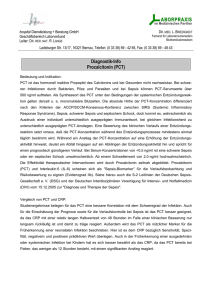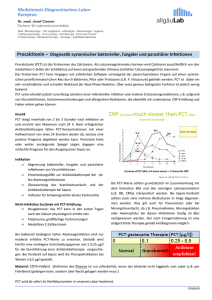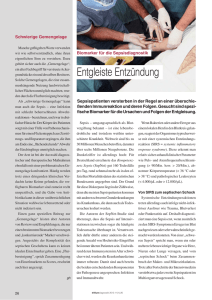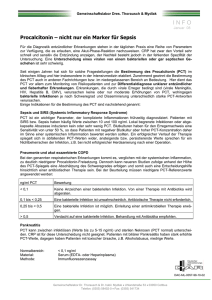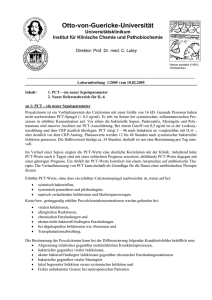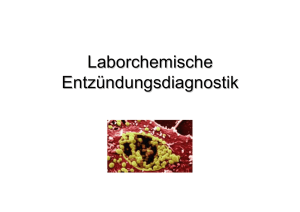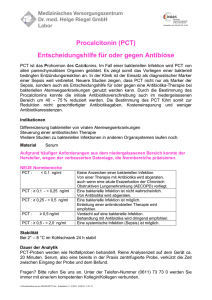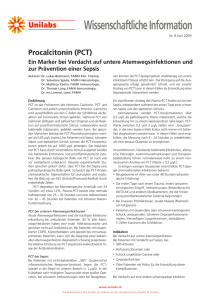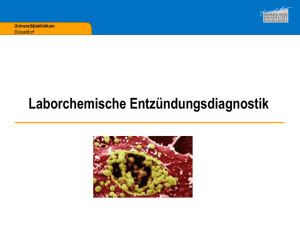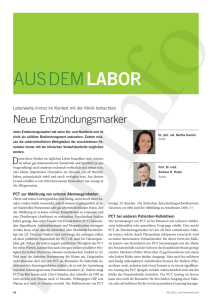PCT
Werbung
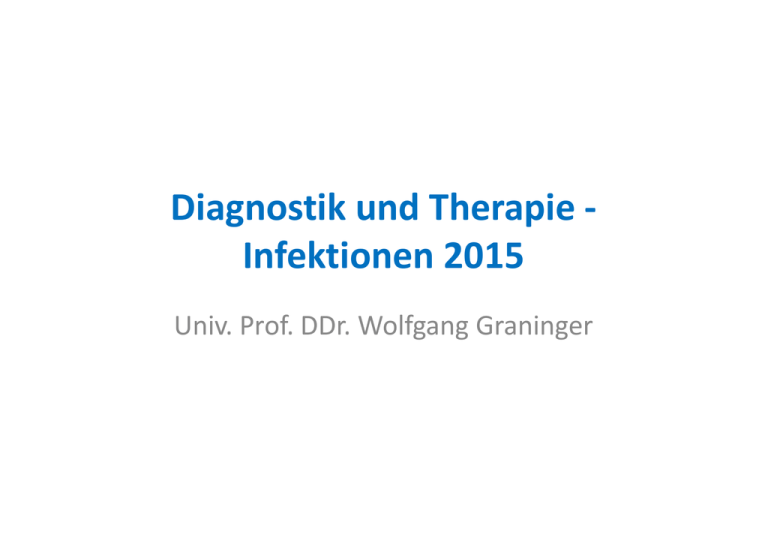
Diagnostik und Therapie Infektionen 2015 Univ. Prof. DDr. Wolfgang Graninger Die „Infektionslatte“ bei Pneumonie Masern HSV, CMV, VZV RSV Influenza A/B Parainfluenza Adenovirus Mycoplasma pneumoniae Die „Infektionslatte“ bei Status febrilis EBV, CMV Influenza A/B Parainfluenza Adenovirus Enteroviren Mumps, Röteln, Masern Toxoplasmose Schwindlige Infektionsparameter Astal Ateich A A-Streptolysin A-StrepDNAase B Candida Ag/Ak Ak gg Mykobakterien (A60) LBP PCT Fibrinogen Ak gg. Chlamydia pneumoniae Standardentzündungsparameter CRP SAA PCT HPT Fe Ferritin Calprotectin IL-6 IL-10 IFN-g Release Assay (IGRA) Drugmonitoring bei infektiösen Erkrankungen • • • • • Aminoglykoside: Gentamicin Glykopeptide: Vancomycin, Teicoplanin Azole Oxazolidinone: Linezolid Makrolide, Rifampicin, Cyclosporin,… • NAT2-Polymorphismus: Isomiazid, Langsamacetylierer • IL28B – Polymorphismus • CYP2C9 Cytochrom P450 – 2C9 Infektionsparameter bei viralen Erkrankungen • Transaminasen • LDH • Lymphopenie • Thrombopenie • Anämie • Neopterin Plasmaproteine bei systemischen bakteriellen Entzündungen Anstieg CRP Serumamyloid A Fibrinogen Haptoglobin saures α1 Glykoprotein Coeruloplasmin α1 Antitrypsin Procalcitonin Leukozytenelastase Abfall Präalbunin Fibronectin Direktnachweis mikrobieller Antigene Pneumokokken Ag Legionellen Ag P. falciparum Candida Ag im Harn Spiegelbestimmungen • Aminoglykoside: Miniumumspiegel (vor Gabe) Kurzinfusion über 30 min Maximumspiegel (30 min nach Ende) Einhaltung der Zeiten extrem wichtig!!! Generell angegebene therapeutische Bereiche: Min < 2 mg/L Max 5 – 10 mg/l • Vancomycin: Miniumumspiegel (vor Gabe) Kurzinfusion über 1 h Maximumspiegel (1 h nach Ende) Therapeutische Bereiche: Min 5 – 10 mg/L Max 20 – 40 mg/l Rey, 2007 Rey, 2007 Rey, 2007 Entdeckung der Antibiotika 1897 1910 1935 1942 1945 1958 1984 Duchesne: Ehrlich: Domagk: Fleming: Waksman: Penicillin Arsphenamin Sulfonamid Penicillin Streptomycin Tetrazykline Makrolide Vancomycin Chinolone Selection of bacteria by antimicrobial treatment Penicillin Klebsiella sp. Cephalosporins Enterococci, ESBL-E. coli Cl. difficile, MRSA P. aeruginosa, S. maltophilia Penems Cl. difficile, C. albicans Quinolones S. aureus, Streptococci QR – E. coli Vancomycin E. coli, Klebsiella sp., VRE COLONIZATION INFECTION Clostridium difficile: Massnahmen 1. Verhinderung - restriktiver Antibiotikagebrauch! - Händehygiene 2. Erkennung 3. Eindämmung - Isolation / Cohorting - spezielle Umgebungsdesinfektion Evidence of safety and treatment effects of faecal transplantation (n=124) • 83% resolution of diarrhea immediately after FT procedure • 95% freedom from diarrhea for 27 months Guo, 2012 ESCAPE • • • • • • Enterococcus faecium (VRE) Staphylococcus aureus (MRSA) Clostridium difficile (NAP1, O27, O78) Acinetobacter baumannii (4MRGN) Pseudomonas aeruginose (3MRGN, 4MRGN) Enterobacteriaceae (E. coli, Klebsiella sp. ESBL, 3MRGN, 4MRGN, CRE, KPC) Percentage of P. aeruginosa isolates in HAIs non-susceptible to carbapenems, by country (n=756 isolates, ECDC PPS 2011-2012 Use carbapenems as initial pluripotent antibiotics and you will end up in colonization with: - Candida - Stenotrophomonas - Acinetobacter - Pseudomonas Glycopeptides Daily doses Vancomycin 3–6g Teicoplanin 0.8 – 1.2 g Dalbavancin Oritavancin Ramoplanin Glycopeptides - Trough Levels 1995 2005 2010 Vancomycin < 10 mg/l < 20 mg/l < 25 mg/l Teicoplanin < 10 mg/l < 25 mg/l < 30 mg/l Drugs of choice against MRSA 2013 Vancomycin, Teicoplanin Daptomycin Linezolid Tri/Sulf Doxycyclin Fusidic acid Aminoglycosides • Gentamicin (Tobramycin) HIGH DOSE SHORT COURSE • Amikacin (Streptomycin) • Individual dosage according to sex, age weight and kidney function • Young man 18 years, 90kg, normal Kidney function Gentamicin 750mg o.d. Amikacin 2000 mg o.d. • Blood level determinations make use expensive Initialtherapie des septischen Patienten Deeskalationstrategie TARRAGONA Eskalationsstrategie COPENHAGEN Meropenem, Vancomycin, Fluconazol Fluconazol ? Pen G Penem Pip/Taz, Cefepim Amoxi/Clav, Cefuroxim Anästhesist Infektosoph Chirurg Warum treten immer mehr resistente Erreger auf? • Geänderte Demographie? • Geographische Unterschiede Kenntnisse der Ärzte unterschiedlich Einfluss der Hersteller • Schnellere Verbreitung von Resistenzmechanismen Kriege Patiententourismus ANTIMICROBIAL STEWARDSHIP “Rufer in der Wüste?“ Therapie der Sepsis durch Klebsiella pneumoniae bei neutropenischen Patienten 1970 Aminoglykosid + Cefazolin 1980 Cefotaxim 1990 Ciprofloxacin 2005 Meropenem 2010 Colistin Therapie der Sepsis durch Pseudomonas aeruginosa beim neutropenischen Patienten 1970 Carbenicillin 2 x 10 g 1985 Piperacillin 3x4g 1995 Ceftazidim 3x2g 2005 Meropenem 3x2g 2015 Colistin ? Optimierte Verwendung von Antibiotika • Schmalspektrum-AB z. B. Pen G bei Streptokokken Oxacillin bei Staphylokokken Fidaxomicin bei Clostridium difficile • Verwendung von Breitspektrum-AB beim Patienten mit Sepsis, Erreger unbekannt z. B. Piperacillin/Tazobactam Amoxicillin/Clavulansäure • Vermeidung der Peneme als Initialtherapie, die “Deeskalation“ findet nie statt • Bronchialsekrete (auch BAL) nicht überbewerten, meist nur Kolonisation (Pseudomonas, Candida, Sterotrophomonas, Acinetobacter) Interventionen 2015 • Infektionsverhütung Hygiene Impfungen Raum und Personal • Antibiotikaverhütung Mikrobiologie Kolonisation vs. Infektion Entzündungsparameter Infektiologen Werbeverbote • Mikrobiologische Interferenz, Phagentherapie, Immuntherapie,… • Tierzucht Was gibt es Neues 2015? Ceftarolin Ceftobiprol Ceftazidim + Avibactam Dalbavancin Oritavancin Torezolid Nemonoxacin Finafloxin Surotomycin Fidaxomycin Sepsis – was kann ich außer AB geben noch tun ? • Immunglobuline • AT 3 • Anti-TNF • Akt. Protein C • Hydrocortison • Clucosekontrolle • Physostigmin • Fokussanierung ? Perspektiven 2013/15 • Es gibt (momentan) keine neuen marktreifen Antibiotika • Die Verwendung der derzeit existierenden Antibiotika muss optimiert werden. “Antibiotic stewardship“ • Mikrobiologische Methoden müssen beschleunigt werden – mit 24 Stundenservice • Der Einfluss von Herstellern auf den Verschreiber muss objektiviert werden • Isolation, Hygienemaßnahmen Acute Phase Proteins Positive acute phase proteins Serum amyloid A C-reactive protein Haptoglobin Fibrinogen Coeruloplasmin α-1-acid glycoprotein PCT, SAA und CRP Serumkonzentration nach TNF-Infusion Nijsten 2000 PCT, SAA und CRP Serumkonzentration nach 7 Tagen IL-6 -Infusion Lebersynthese nach TNF bzw. IL-6 Exposition in vitro Nijsten 2000 PCT und IL-6 bei neonataler Sepsis (n=17/9) PCT Überlebt Tot IL-6 Überlebt Tot Tag 0 Tag 3 Tag 7 2-89 (10) 0.2-92 (1) 0.2-69 (0.7) 0.4-68 (3) 0.4-94 (9) 4.8-96 (92) 4,8-78 (20) 2.1-43 (9) 1-24 (3.7) 3.1-18 (10) 9.8-39 (22) 11-55 (40) Kocabas, 2007 ROC-Kurven: APP bei neonataler Sepsis Kocabas 2007 Accuracy of PCT for sepsis diagnosis • 18 studies: sensitivity and specificity of 0.78 procalcitonin cannot reliably differentiate sepsis from other causes for SIRS • Evidence does not lend support to the widespread use of procalcitonin test Tang, Infection.the lancet 2007 Acute Phase Proteins Negative acute phase proteins Transferrin Transthyretin Rehinolbindung protein Fibronectin Albumin Fibronektin • In der Leber synthesiert • Permanent nieder = Zi, … • Vorübergehender Abfall nach Zytokinsturm z.B. Sepsis • Fibronektin < 8 mg/dl = tot > 40 mg/dl = hält alles aus Akutphasenparameter (APP) bei bakteriellen Infektionen PCT 100 € 40 SAA €3 CRP €1 1 24h FN € 3 Reaktionsschnelligkeit der Sepsisparameter TNF IL-6 PCT SAA CRP FN PA HPT Fehlerquellen • Anstieg der APP zu träge PCT > CRP > HPT • Nur einmalige Bestimmung • Insensitive Methoden zur Bestimmung • Andere ‚Entzündungsquellen‘ Malaria, Trauma, Verbrennungen FMF, Pankreatitis Gesunder Patient stirbt zufällig • 52 jähriger Polizeibeamter mit nutritiv toxischer Hepatopathie • wird 500m von Wirtshaus entfernt im Straßengraben benommen aufgefunden • Ausnüchterungszelle – wird nicht nüchtern • Krankenhaus: benommen kein PCT, kein CRP Temp. 37,5°C abwarten • Tot Obduktion: Pneumokokkenmeningitis
